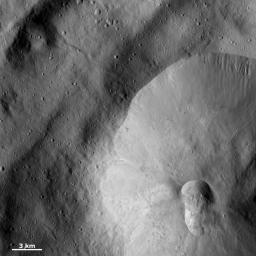A double crater, called a crater doublet, is seen in the bottom right part of this framing camera (FC) image of Vesta. This crater doublet was likely formed by the simultaneous impact of two fragments of a split projectile, or of two mutually orbiting impactors. The area outside the larger crater, in which the crater doublet formed, features a high density of smaller craters, locally in clusters or chains. There are also gullies formed on the edge of the large crater, which are particularly clear along the top rim of the crater. The area shown in this image is located on the floor of Vesta's large south-polar impact structure, named Rheasilvia.
This image is located in Vesta's Rheasilvia quadrangle, near the vestan south pole. NASA's Dawn spacecraft obtained this image with its framing camera on Dec. 20, 2011. This image was taken through the camera's clear filter. The distance to the surface of Vesta is 270 kilometers (168 miles) and the image has a resolution of about 25 meters (82 feet) per pixel. This image was acquired during the LAMO (low-altitude mapping orbit) phase of the mission.
The Dawn mission to Vesta and Ceres is managed by NASA's Jet Propulsion Laboratory, a division of the California Institute of Technology in Pasadena, for NASA's Science Mission Directorate, Washington D.C. UCLA is responsible for overall Dawn mission science. The Dawn framing cameras have been developed and built under the leadership of the Max Planck Institute for Solar System Research, Katlenburg-Lindau, Germany, with significant contributions by DLR German Aerospace Center, Institute of Planetary Research, Berlin, and in coordination with the Institute of Computer and Communication Network Engineering, Braunschweig. The Framing Camera project is funded by the Max Planck Society, DLR, and NASA/JPL.
More information about the Dawn mission is online at http://www.nasa.gov/dawn and http://dawn.jpl.nasa.gov.

 Planetary Data System
Planetary Data System












